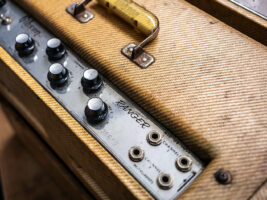
Amp FAQ: Servicing Bernie Marsden’s vintage Gibson amps (Part 2)
Appearing in the 1960 Gibson catalogue alongside the Lancer, the GA-20 model was available in two versions, the Crest and Ranger. The latter came with a ‘T’ suffix (GA-20T) indicating that it had onboard tremolo, while the Crest was left without. Rated at a modest 16 watts, it was primarily aimed at pro players and came with a hefty $189.50 price-tag (approx $1,750 in today’s money) to boot.
READ MORE: Amp FAQ: Servicing Bernie Marsden’s vintage Gibson amps (Part 1)
This particular amplifier, serial number #38949, dates to early 1961 and just like the Lancer, is in great condition. It’s had some maintenance over the years and is in okay health, but does need a little love and care for its upcoming workload.
The internal build quality is excellent for the period, with high-quality components throughout
Go go power Ranger
This amp was imported from the USA at some time in its life, and someone has installed an external step-down transformer in the rear of the cabinet, allowing the user to plug the amplifier into a UK wall socket and use the Ranger without fuss. Unfortunately, the transformer is both far too large and far too powerful for the GA-20T’s requirements, and was shoe-horned into the cabinet in the only place it would fit, right next to the preamp valves.
For those not familiar with best practices in chassis layout, a designer must do everything in their power to have the super-sensitive preamp section as far away as possible from the mains supply in order to avoid unwanted noise. Placing a huge transformer right next to the preamp section is probably the worst thing that you can do, and this amp emits the tell-tale 50Hz hum from the speaker when powered up. Time to get that sorted, then.
On the test bench, the amplifier draws around 65 watts in use, with a peak of around 80 watts if I push it beyond its normal operating conditions. With that in mind, a 100-watt transformer is more than enough for this amplifier, and is much smaller too. Using the same bracketry as the old unit, the new transformer is installed on the other side of the cabinet, tucked out of sight and, crucially, away from the preamp. With the cables routed and secured correctly, firing up the amplifier reveals that our hum is no longer present and we can continue with our service work.
Some of the components are found hidden on the backside of the board
Home on the Ranger
I’m mightily impressed with the build quality inside the chassis, with real care and attention paid to wire runs and component position. When it comes to servicing, the main component board is the only fly in the ointment, as components are mounted on both sides, making replacement rather fiddly.
During the play-test, I’ve noticed that one of the input sockets intermittently produces a hum after you’ve unplugged from it, and that one of the 6V6 valve sockets produces a crackle when the valve is wobbled. Thankfully, this is all easily rectified with Servisol spray and some elbow (finger?) grease.
The power transformer is branded ‘Gibson’
With these minor issues sorted, it’s time to check the bias and measure the output power. The pair of 6V6s in this amplifier share a common cathode resistor and using simple ohms law to calculate the current flowing through each valve, I discover that they are running slightly hot.
The resistor should be 200 ohms, but measures someway short of that at 172 ohms. Swapping this out for the nearest modern standard value of 220 ohms brings the operating conditions of the 6V6s back in line with expectations. A quick check on the oscilloscope reveals no crossover distortion, an indication of too cold a bias, so we’re good to go.
Our replacement step-down transformer sits neatly inside the cabinet
Output power is a smidge over 16 watts and our final play-test shows off just how good this amplifier sounds. The P12R speaker is perfectly broken in by now, and shrugs off any abuse that we give it.
The 1960 catalogue says that the Ranger has “clear, clean tones and solid undistorted response”, and I couldn’t agree more. Such richness in tone is rarely found today. If you ever come across one of these amplifiers, buy it without hesitation.
Visit riftamps.com for more on Chris Fantana’s range of UK-built boutique amps.
The post Amp FAQ: Servicing Bernie Marsden’s vintage Gibson amps (Part 2) appeared first on Guitar.com | All Things Guitar.
Source: www.guitar-bass.net












